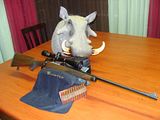.300 H&H is the grandfather of .30 magnums
Introduced in 1925, it and the .375 H&H (introduced in 1912) were the original belted magnums. In fact, the term "Magnum" was first applied to these rounds by Holland & Holland as a marketing ploy, deriving from the name for a larger than standard bottle of champaigne. The H&H Magnums had larger than standard cases, and delivered higher velocities than previously available. The .300 H&H has a long tapered body, without much of a shoulder, making reloading somewhat challenging for maximum case life, as it headspaces on the belt, chamber and sizing die dimensions vary a bit.
The .300 H&H case has been the parent case of several wildcat rounds, someof which eventually became standard factory items, such as the .300 Weatherby. The .300 H&H gets about 200 fps more velocity than the .30-06, and 1-200 fps less velocity than other .30 magnums, based on the blown out (expanded) H&H case body, which hold a bit more powder.
The 300 H&H or 300 Super as it is also known, was a low pressure round. It was developed to duplicate the ballistics of the older 30-06, but at lower pressure for reliability.
This statement is not accurate. Although the .300 H&H was also known as Holland's Super .30, there is no "older .30-06" loading duplicated by it, it infact outperforms the modern .30-06 loadings by a significant margin. The original .30-06 loading was the GI ball, either a 173gr @ 2640 +/-30fps or a 150gr @ 2740 +/-30fps. The .300 H&H shoots the 150 @ 3190fps and the 180gr @ 2920fps (given slight variation for indiviual rifles and barrel lengths).
Although introduced in 1925, only Griffith & Howe custom rifles were available in .300 H&H until 1937 when Winchester chambered the Model 70 for it. Remington also chambered the model 721, and later model 700 in this caliber, somewhat later. Modestly popular as the "big stick" of .30 caliber rifles, the popularity has faded since the introduction of the "short magnums", and larger capacity magnums, like the .300 Weatherby, beginning in the late 1950s. They are known as short magnums because they are shorter than the .300/.375 H&H, and will fit into standard (.30-06) length actions, which the H&H rounds will not. More recently there has been a number of "super short magnums" introduced, which use even larger diameter case bodies, without belted heads. They are completely different cartridges, and should not be confiused with "regular" belted magnums.
Ammo is not common for the .300 H&H in the US, but is available. Recoil of the .30 caliber magnums is all pretty close to the same, with the fit of the rifle (and its weight) being more important for moderating recoil than the actual cartridge (.300 H&H, .308 Norma, .300 Winchester, .300 Weatherby). They all kick quite a bit, and are very loud, because they all burn around 70 or more grains of powder.
Unless you have a good dependable source for .300 H&H ammo, and/or can get it a lower cost, there is not any real benefit to choosing this fine old round over newer ones in the same power class. Accuracy will be up to the individual rifle, not the cartridge design. The 1,000 yard Wimbeldon Cup match was won by a .300 H&H in 1935, and the superior long range performance over contemporary rounds gave the H&H an advantage for several years, but it has long been replaced by others for long range target shooting. It has proven istelf as a fine performer on game, at any range they can humanely be taken, and is at its best overall with a good 150gr or 180gr bullet, depending on the game to be taken.



